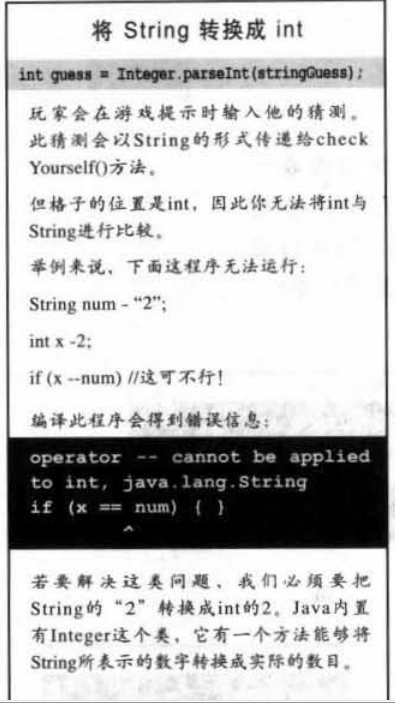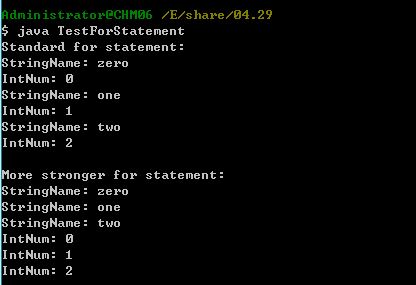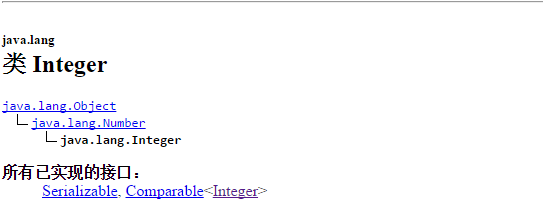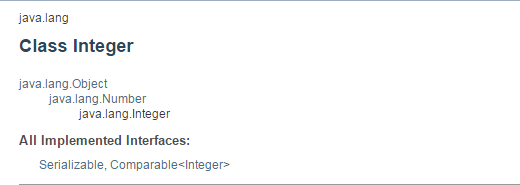这一章作者开始带我们写稍微复杂一点点的程序了。暂不去讨论里面的程序,我们来说说新学到的知识。
加强版的for循环和String转化为int
好的,为了测试上面新学到的两个知识,写了如下代码TestForStatement.java:
public class TestForStatement{
public static void main(String[] args)
{
int i = 0;
int number = 0;
String[] nameArray = new String[3];
String[] numArray = new String[3];
nameArray[0] = "zero";
nameArray[1] = "one";
nameArray[2] = "two";
numArray[0] = "0";
numArray[1] = "1";
numArray[2] = "2";
// 普通版for循环
System.out.println("Standard for statement:");
for(i=0; i<nameArray.length; i++)
{
System.out.println("StringName: " + nameArray[i]);
number = Integer.parseInt(numArray[i]);
System.out.printf("IntNum: %d\n", number++);
// 不能这么做,因为Integer.parseInt()返回的是一个值而不是变量,无法进行++操作
//System.out.printf("IntNum: %d\n", (Integer.parseInt(numArray[i]))++);
}
System.out.println();
// 加强版for循环
System.out.println("More stronger for statement:");
for(String name : nameArray)
{
System.out.println("StringName: " + name);
}
for(String num : numArray)
{
number = Integer.parseInt(num);
System.out.printf("IntNum: %d\n", number++);
}
}
}运行结果如下:
普通版和加强版for循环的比较
普通版for循环:
for(i=0; i<nameArray.length; i++)加强版for循环
for(String name : nameArray)加强版的for循环较之于普通版主要是省略掉了循环结束标记和自增操作。使用加强版for循环,程序知道什么时候结束(重复执行至所有的元素都被执行为止),自动每次”加1”跳到下一个元素。且一个加强版的for循环只能遍历一个集合,如果想遍历多个集合,就得有多个加强版for循环。这样一看,加强版只适用于依次遍历一个集合中所有的元素这种场合中,你不能只想执行编号为奇数或偶数的元素。但是,之所以成为加强版for循环是因为它用起来方便,肯定是要经常使用到类似的情况所以才会出一个加强版的for循环的。
与此相比较的普通版for循环有更大的灵活性,从哪个位置开始循环、何时停止循环、增量是多少都很方便控制,唯一要注意千万不能越界获取元素,那样总会出现不可预知的后果。
String转换为int
我们新学到了一个方法:Integer.parseInt()。那么这个具体是什么呢?怎么使用呢?怎么实现的呢?
Java API文档
带着这些疑问,我们开始查找Integer这个类。Java 中文API文档和Java英文API文档都对这个类有详细的说明。在以后的学习中,肯定是经常要去查看这两份API文档的。
通过这两份API文档,我们可以查找到Integer这个类的相关信息。
1> 位于哪个包和接口信息
2> 该类的简要信息
3> 该类的字段(属性)摘要信息
4> 该类的构造方法摘要信息
5> 该类的方法摘要信息
6> 该类的属性、方法的详细信息
详细信息都罗列在摘要的后面,这可不能错过。
Java 源码
通过Java API文档我们知道Integer类中parseInt()方法的使用方法:
顾名思义,Java API文档只提供接口信息,并没有提供方法的具体实现是怎么做的?那么我们想看方法的具体实现怎么办呢?
答案是在安装目录下有源码,以我的为例是在:%JAVA_HOME%\jdk1.7.0_21\src_zip 这个文件,解压改文件找到对应的类就可以了。
下面是parseInt(String s)的源代码:
/**
* Parses the string argument as a signed decimal integer. The
* characters in the string must all be decimal digits, except
* that the first character may be an ASCII minus sign {@code '-'}
* (<code>'\u002D'</code>) to indicate a negative value or an
* ASCII plus sign {@code '+'} (<code>'\u002B'</code>) to
* indicate a positive value. The resulting integer value is
* returned, exactly as if the argument and the radix 10 were
* given as arguments to the {@link #parseInt(java.lang.String,
* int)} method.
*
* @param s a {@code String} containing the {@code int}
* representation to be parsed
* @return the integer value represented by the argument in decimal.
* @exception NumberFormatException if the string does not contain a
* parsable integer.
*/
public static int parseInt(String s) throws NumberFormatException {
return parseInt(s,10);
}
下面是parseInt(String s, int radix)的源码:
/**
* Parses the string argument as a signed integer in the radix
* specified by the second argument. The characters in the string
* must all be digits of the specified radix (as determined by
* whether {@link java.lang.Character#digit(char, int)} returns a
* nonnegative value), except that the first character may be an
* ASCII minus sign {@code '-'} (<code>'\u002D'</code>) to
* indicate a negative value or an ASCII plus sign {@code '+'}
* (<code>'\u002B'</code>) to indicate a positive value. The
* resulting integer value is returned.
*
* <p>An exception of type {@code NumberFormatException} is
* thrown if any of the following situations occurs:
* <ul>
* <li>The first argument is {@code null} or is a string of
* length zero.
*
* <li>The radix is either smaller than
* {@link java.lang.Character#MIN_RADIX} or
* larger than {@link java.lang.Character#MAX_RADIX}.
*
* <li>Any character of the string is not a digit of the specified
* radix, except that the first character may be a minus sign
* {@code '-'} (<code>'\u002D'</code>) or plus sign
* {@code '+'} (<code>'\u002B'</code>) provided that the
* string is longer than length 1.
*
* <li>The value represented by the string is not a value of type
* {@code int}.
* </ul>
*
* <p>Examples:
* <blockquote><pre>
* parseInt("0", 10) returns 0
* parseInt("473", 10) returns 473
* parseInt("+42", 10) returns 42
* parseInt("-0", 10) returns 0
* parseInt("-FF", 16) returns -255
* parseInt("1100110", 2) returns 102
* parseInt("2147483647", 10) returns 2147483647
* parseInt("-2147483648", 10) returns -2147483648
* parseInt("2147483648", 10) throws a NumberFormatException
* parseInt("99", 8) throws a NumberFormatException
* parseInt("Kona", 10) throws a NumberFormatException
* parseInt("Kona", 27) returns 411787
* </pre></blockquote>
*
* @param s the {@code String} containing the integer
* representation to be parsed
* @param radix the radix to be used while parsing {@code s}.
* @return the integer represented by the string argument in the
* specified radix.
* @exception NumberFormatException if the {@code String}
* does not contain a parsable {@code int}.
*/
public static int parseInt(String s, int radix)
throws NumberFormatException
{
/*
* WARNING: This method may be invoked early during VM initialization
* before IntegerCache is initialized. Care must be taken to not use
* the valueOf method.
*/
if (s == null) {
throw new NumberFormatException("null");
}
if (radix < Character.MIN_RADIX) {
throw new NumberFormatException("radix " + radix +
" less than Character.MIN_RADIX");
}
if (radix > Character.MAX_RADIX) {
throw new NumberFormatException("radix " + radix +
" greater than Character.MAX_RADIX");
}
int result = 0;
boolean negative = false;
int i = 0, len = s.length();
int limit = -Integer.MAX_VALUE;
int multmin;
int digit;
if (len > 0) {
char firstChar = s.charAt(0);
if (firstChar < '0') { // Possible leading "+" or "-"
if (firstChar == '-') {
negative = true;
limit = Integer.MIN_VALUE;
} else if (firstChar != '+')
throw NumberFormatException.forInputString(s);
if (len == 1) // Cannot have lone "+" or "-"
throw NumberFormatException.forInputString(s);
i++;
}
multmin = limit / radix;
while (i < len) {
// Accumulating negatively avoids surprises near MAX_VALUE
digit = Character.digit(s.charAt(i++),radix);
if (digit < 0) {
throw NumberFormatException.forInputString(s);
}
if (result < multmin) {
throw NumberFormatException.forInputString(s);
}
result *= radix;
if (result < limit + digit) {
throw NumberFormatException.forInputString(s);
}
result -= digit;
}
} else {
throw NumberFormatException.forInputString(s);
}
return negative ? result : -result;
}说实话,在没看到这两段源代码之前,我天真的以为String类型转换为int类型很简单。无非就是计算String的长度,然后根据数字在元素中的位置乘以相应的倍数即可。唉!太天真了,在源码中有对传入参数的有效性做判断、有对数值范围做判断,然后根据情况抛出对应的异常。你看人家想得多周到。。。




































 939
939

 被折叠的 条评论
为什么被折叠?
被折叠的 条评论
为什么被折叠?








